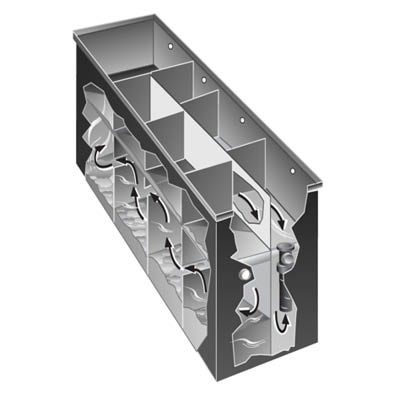For use in mechanical washing facilities for cars, trucks, buses, tractors, and other vehicles. For inside or outside installation, to receive sand, gravel, and similar matter as well as any oil and greasy waste contained therein. There is no straight in-and-out travel of waste water.
DESIGN
The GSS Series Separator is designed for the specific purpose of retaining and separating sand, gravel and similar waste material, in addition to any oily or greasy wastes contained therein. This is accomplished through the characteristic features of minimum turbulence, maximum length of water travel, and internal flow regulation through its screens.
The Rockford design utilizes the principle of nature’s own law of gravity in separating lighter-than-water waste, retaining both in the separator. Light oily and greasy waste matter rises to the surface, while the heavy solids and sand sink to the bottom (refer to cut-open view above). Mechanical pumping is the customary method of cleaning out the accumulated waste matter.
CONSTRUCTION
Built of all-welded 1/4″ heavy-duty steel plate for strength and durability. Removable covers constructed of 3/8″ nonskid diamond pattern treadplate for flush-with-floor installation suitable for pedestrian traffic and secured to body of unit with recessed stainless steel bolts. (Covers can be reinforced for installation in an area subject to vehicular traffic.) Extra-heavy leakproof and airtight gasket. Standard tapped inlet and outlet. Four independent internal vent connections to prevent pressure build-up and to release fumes of spilled gasoline, solvents, etc., which are major fire hazards. Protective seal outlet acceptable to all plumbing codes. All units are available in double-wall construction with leak detection if specified.
COR-TEN® INFORMATION
Cor-Ten® high-strength, low carbon steel with its high strength and outstanding resistance to atmospheric corrosion is available where maintenance cost savings are prime considerations. Even in an unpainted condition, Cor-Ten® has a tightly adherent oxide surface which stops further oxidation. Painted or coated, this characteristic is further enhanced. The reliability and strength of this material has been proven in many applications, such as railroad cars, bridges and two of the tallest buildings in the world: the John Hancock Building and the Sears Tower in Chicago.
METHOD OF OPERATION
The flow of waste water through the separator is controlled by ingeniously spaced stationary baffles which divide the separator into compartments of varying sizes, as shown in the cut-open view above.



